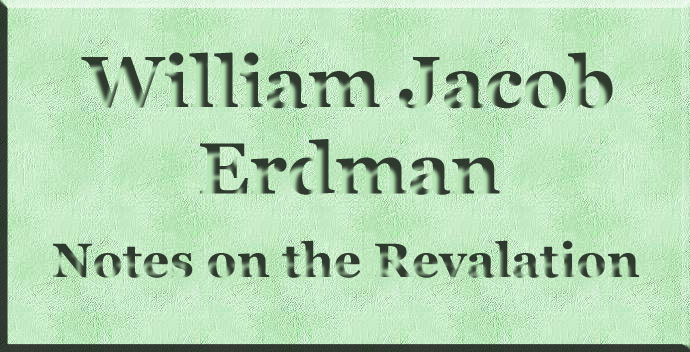
Notes on the Revelation
By W. J. Erdman D.D.
Chapter
The prologue. Revelation 1:1-8.
The Introduction or Prologue to the Revelation, consists of an Inscription, a Salutation, and a statement of the Theme or Subject of the Book. The Inscription, vs. 1-3, begins with the word which has given the Book its name. “Revelation” (Greek “Apocalypse”) means an “unveiling,” and particularly the revealing of future events. Of this Revelation Christ is declared to be the Author. It has been given by God the Father to his Son, that the Son may “ show unto his servants things which must shortly come to pass.” This Revelation is committed by Christ through his angel to his Apostle John. It has come to John in the form of visions, and he is writing “ the things that he saw.” A blessing is pronounced upon the (public) reader of the Book and upon those (present) who hear what is read, and upon those who allow the teachings to influence their lives. The Salutation, vs. 3-6, indicates that the entire Book was to be sent to each one of the churches, and hot merely the one letter addressed to that church. These churches together represent the Universal Church. To these churches, John sends the usual apostolic greeting of “ grace ” and “ peace,” and he unites in his salutation the three Persons of the Trinity.. The Father is described as “ he who is and was and is to come.” The Spirit is denoted by his seven-fold operations, as “ The seven Spirits that are before his throne.” The Son is pictured in the character in which he appears in the Book, as “ The Revealer,” “ the Risen One,” and “ the Ruler of the earth,” To him “ glory and dominion ” are ascribed as to him who has “ loved us and loosed us from our sins and made us to be a kingdom, to be priests unto his God and Father.” The Theme, vs. 7, is the Coming of Christ, and the Revelation is a book of visions concerning his second advent and the events which precede and follow his glorious reappearing. The visions foretell the future of the Church both of the True and the False; of the World Power under the final head, the Beast; of the Nations of the world and of the Kingdom of God. The establishment of this kingdom over the earth is the goal of all the movements through Seals and Trumpets and Vials. This goal is reached twice in the course of the visions, at 11:15-16 and at 19:6 and the context following; so in addition to the seven-fold division of the Book it may be regarded as being divided into two parts, Chapters 1 to 11 and Chapters 12 to 22. Whatever definitions or theories of the Kingdom of God as something now existing or to be advanced upon the earth which men may give or act upon, it is evident from these Visions of the Apocalypse that this perfected Kingdom is still future.
|
|
 |
 |
|
[Note by the Editor: As thus indicated, the author belonged to the “ Futurist ” school of interpreters. He regarded the Anti-Christ, or the “ Beast,” and the Great Tribulation, and the perfected Kingdom of God, as depicting persons or events still to appear. The “Preterist ” interpreters regard Nero as the Anti-Christ, and find the pictures of the Apocalypse fulfilled largely by the Emperor-worship and the persecutions of the Church in the early Christian centuries. The “ Historical ” interpreters regard the Pope of Rome as the Anti-Christ, and find in the Revelation a prediction of the rise and fall of the Papacy. The “ Spiritualizes ” regard the Book as containing no prophecies of coming persons or events, but symbols and illustrations of abiding spiritual and moral principles. Whatever of truth the author saw in these other schools of interpretation, he regarded the Apocalypse as mainly concerned with prophecies concerning the end of the present age and the personal return of Christ. He belonged, however, to the more conservative and restrained group of interpreters. He saw that the in spired Seer swept the whole horizon of events from the birth of Christ to His coming again in glory. ^ In type and symbol he found indications of revolutions and convulsions, but of the continuous and ultimate triumph of the cause of God upon earth, until “ the kingdoms of this world are become the kingdoms of our Lord and of his Christ.”]
|
|
-
Site Navigation
 Home
Home What's New
What's New Bible
Bible Photos
Photos Hiking
Hiking E-Books
E-Books Genealogy
Genealogy Profile
Free Plug-ins You May Need
Profile
Free Plug-ins You May Need
 Get Java
Get Java.png) Get Flash
Get Flash Get 7-Zip
Get 7-Zip Get Acrobat Reader
Get Acrobat Reader Get TheWORD
Get TheWORD